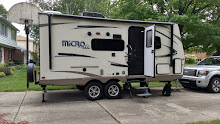For
several reasons, we wanted to drive into Yuma on Wednesday. We started at the
main Library, where we had minimal data access but Marv downloaded some “Grace
and Frankie” shows for us to watch on his tablet when we don’t have electricity
and I talked to the reference librarian about things to do in Yuma. She printed
a Yuma hiking and biking trails map for us and suggested we go to the Visitors’
Center on Avenue B for more information. From there we could bike east along
the Colorado River to Gateway Park and into the Historic Downtown district of
Yuma. The town was only truly formed in 1914 and the district is about 3 blocks
long, once containing the Post Office, a bank building, JC Penney, and a saloon
and ballroom or two. The recommended place, Lute’s Restaurant, was very busy with people waiting out
front to get in and so we went on to Prison Hill Brewery for lunch. Its beer
and entree names were cute twists on prison lingo and it notes that the Brewery
is crawling distance from the old Territorial Prison, notorious for having the
first 7 inmates build their adobe cells themselves and then incarcerating them
in them. The prison is now a State Park and you can see the original cells on
the hill nearby.
We
returned to the river trail and followed it west to the West Wetlands Park and
back to a different trail to Pivot Point Park. Yuma has been known for
centuries as the narrows for, and only crossing for, the Colorado River. In 1540, Spanish
colonial expeditions under Hernando de
Alarcon and Melchior Diaz visited
the area and immediately recognized the natural crossing of the Colorado River
as an ideal spot for a city. The Colorado
River narrows to slightly under 1,000 feet wide in one area.
Military expeditions that crossed the Colorado River at the Yuma Crossing include Juan Bautista de Anza (1774), the Mormon Battalion (1848) and the California Column (1862). During and after
the California Gold Rush to the late
1870s, the Yuma Crossing was known for its ferry crossings for the Southern Emigrant Trail. This was considered
the gateway to California, as it was one of the few natural spots where
travelers could cross the otherwise very wide Colorado River.

The crossing was controlled by the Quechan Indians until the
US Army took it over during the Gold Rush and also acquired thousands of acres
of rich ancestral farmland. Recently some of the land has been restored to the
tribe and they have been primary planners in restoring the wetlands that have
been destroyed as people have tried to tame the Colorado River. In fact,
because of the extensive dams, canals, settling tanks, and agriculture along
the lower Colorado, it is a dead river with no water by the time it reaches
Mexico, just 20 miles away. As you can guess, Mexico isn’t very happy about
that…
After riding about 7 miles altogether, we did some grocery
shopping and got to a Brewers Sports Bar that had the Big Ten Network and could
show us MSU’s basketball game against Rutgers, their first game without the
injured Nick Ward. It was another harrowing game, where they were down about 12
points at the half but pulled ahead and won convincingly by the end.

No comments:
Post a Comment